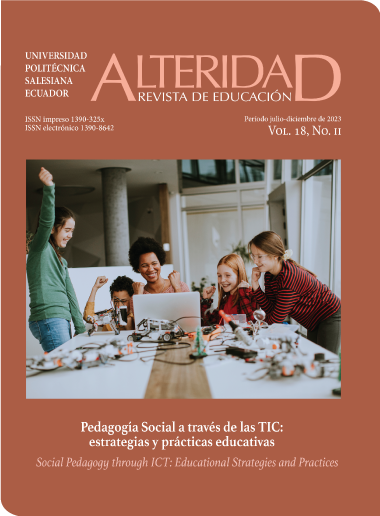Quality of textbooks from the knowledge management perspective
Main Article Content
Abstract
Article Details

This work is licensed under a Creative Commons Attribution-NonCommercial-ShareAlike 4.0 International License.
Authorship: The list of authors signing must include only those people who have contributed intellectually to the development of the work. Collaboration in the collection of data is not, by itself, a sufficient criterion of authorship. "Alteridad" declines any responsibility for possible conflicts arising from the authorship of the works that are published.Copyright: The Salesian Polytechnic University preserves the copyrights of the published articles, and favors and allows their reuse under the Creative Commons Attribution-NonCommercial-ShareAlike 3.0 Ecuador license. They may be copied, used, disseminated, transmitted and publicly displayed, provided that: i) the authorship and the original source of their publication (journal, editorial and work URL) are cited; (Ii) are not used for commercial purposes; Iii) mention the existence and specifications of this license.
References
Anderson, L. W., & Krathwohl, D. R. (2001). A taxonomy for learning, teaching, and assessing, Abridged Edition. Boston, MA: Allyn and Bacon,
Barrows, H. S., Wilkerson, L., & Gijselaers, W. H. (1996). Bringing problem-based learning to higher education: theory and practice. New Directions For Teaching and Learning Series, 68, 3-11.
Bednárik, M., ?okyna, J., Ostertágová, A., Rehúš, M.: Ako?v ?ase krízy zabezpe?i? prístup k vzdelávaniu pre všetky deti. Inštitút vzdelávacej politiky, 2020, 24 pp.
https://www.ozskolstva.sk/files/korona%20opatrenia%20komentar_final.pdf
Bloom, B. S., Engelhart, M. D.; Furst, E. J.; Hill, W. H.; Krathwohl. D. R. (1956). Taxonomy of educational objectives: The classification of educational goals. Handbook I: Cognitive domain. New York: David McKay Company.
Caroll, L. (1865). Alice’s Advantures in Wonderland, Macmillan, London.
Clark, D. (2004). Bloom’s Taxonomy of Learning Domains.
http://www.nwlink.com/~donclark/hrd/bloom.html
Chamovitz, D. (2017). What a plant knows: A field Guide to the senses. Farrar, Straus and Giraux, New York.
Dávideková, M., Hvorecký, J. (2017). ICT Collaboration Tools for Virtual Teams in Terms of the SECI Model. International Journal of Engineering Pedagogy, Vol. 7 Issue 1, p. 95-116
Eurostat (2021) Individuals – internet use, [Online], Available: https://ec.europa.eu/eurostat/databrowser/view/isoc_ci_ifp_iu/default/bar?lang=en
Harrison, R. (2009). Learning and Development. Chartered Inst of Pers/Develop, 5th Edition.
Hug, T. (2007). Didactics of Microlearning. Waxmann Verlag, New York, 2007, 419 pp.
Hvorecký, J. (2018). Me?avce: Ve?ký tresk. Raabe, Bratislava
Hvorecký, J., Kore?ová, L. (2018). Learning Critical Thinking without Teacher’s Presence. Proceedings of 12th International Scientific Conference on Distance Learning in Applied Informatics, pp. 293-302
Hvorecký, J., Šimúth, J., Lichardus, B. (2013). Managing Rational and Not-Fully-Rational Knowledge. Acta Polytechnica Hungarica Vol. 10, No. 2, pp. 121-132
Jordan, Z., & Karunananthan, S. (2020). The hardest thing about learning is unlearning: why systematic review replication should be reconsidered. JBI Evidence Synthesis, 18(11), 2194-2195.
Knuchel, C, (2004). Teaching Symmetry in the Elementary Curriculum, The Mathematics Enthusiast: Vol. 1 : No. 1 , Article 2. DOI: https://doi.org/10.54870/1551-3440.1001
Love, P. E., Smith, J., & Teo, P. (2018). Putting into practice error management theory: unlearning and learning to manage action errors in construction. Applied ergonomics, 69, 104-111.
Majewski, M. (2011). Geometric ornaments in Istanbul. In Proceedings of the 16th Asian Technology Conference in Mathematics (pp. 19-23).
Meriam-Webster Dictionary: Quality. https://www.merriam-webster.com/dictionary/quality
Kimiz Dalkir (2017) Knowledge Management in Theory and Practice. The MIT Press, 552 pp.
Lord, T., & Baviskar, S. (2007). Moving students from information recitation to information understanding-Exploiting Bloom's Taxonomy in creating science questions. Journal of College Science Teaching, 36(5), 40.
Meriam-Webster: Symmetry. Symmetry Definition & Meaning - Merriam-Webster (naoxinkang.com)
Nonaka, I., Takeuchi, H. (1995) The Knowledge-Creating Company – How Japanese Companies Create the Dynamics of Innovation. Oxford University Press, London.
Nilssen, J. H. (2015). The challenge of raising the quality of the textbook and its companion website–Just when is less more?. Procedia-Social and Behavioral Sciences, 178, 164-168.
Sverdrup-Thygeson, A. (2018), Insektenes planet – Om de rare, nyttige og fascinerende småkrypene vi ikke kan leve uten, Stilton Literary Agency.
Wikipedia: Tacit knowledge. https://en.wikipedia.org/wiki/Tacit_knowledge
Wilson, L. O. (2016). Anderson and Krathwohl–Bloom’s taxonomy revised. Understanding the New Version of Bloom's Taxonomy.

